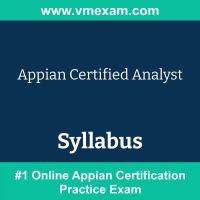 The Appian Analyst exam preparation guide is designed to provide candidates with necessary information about the Analyst exam. It includes exam summary, sample questions, practice test, objectives and ways to interpret the exam objectives to enable candidates to assess the types of questions-answers that may be asked during the Appian Certified Analyst exam.
The Appian Analyst exam preparation guide is designed to provide candidates with necessary information about the Analyst exam. It includes exam summary, sample questions, practice test, objectives and ways to interpret the exam objectives to enable candidates to assess the types of questions-answers that may be asked during the Appian Certified Analyst exam.
It is recommended for all the candidates to refer the Analyst objectives and sample questions provided in this preparation guide. The Appian Analyst certification is mainly targeted to the candidates who want to build their career in Analyst domain and demonstrate their expertise. We suggest you to use practice exam listed in this cert guide to get used to with exam environment and identify the knowledge areas where you need more work prior to taking the actual Appian Certified Analyst exam.
Appian Analyst Exam Summary:
|
Exam Name
|
Appian Certified Analyst |
| Exam Code | Analyst |
| Exam Price | $200 USD |
| Duration | 60 minutes |
| Number of Questions | 50 |
| Passing Score | 70% |
| Schedule Exam | Appian Community |
| Sample Questions | Appian Analyst Sample Questions |
| Recommended Practice | Appian Certified Analyst Practice Test |
Appian Analyst Syllabus:
| Section | Objectives | Weight |
|---|---|---|
| Introduction to the Appian Platform |
- Identify the purpose of each Appian object - Identify commonly used Appian resources (i.e., Appian Community, playbook, help documentation) - Recognize role-based application security - Describe common Appian use cases (i.e., platform capabilities) - Recognize different Appian user experiences - Differentiate between Appian Designer, Appian Process Modeler, and Cloud Database - Design the user experience (in collaboration with the development team) - Identify use cases likely to require third-party components (e.g., DocuSign, Google APIs) |
24% |
| Appian Software Development Lifecycle (SDLC) |
- Identify the role of the analyst across all phases of the SDLC (initial, build, release, optimize) - Recognize the roles and associated responsibilities of team members - Differentiate between various stages of the Appian SDLC - Describe the scrum lifecycle of a user story, including Definition of Done (DoD) and Definition of Ready (DoR) - Explain the different agile scrum ceremonies - Identity use cases for various environments - Evaluate the test scenario before user acceptance testing (UAT) |
22% |
| Requirements Gathering |
- Identify the purpose of requirement gathering - Identify the characteristics of requirements gathering - Explain how Appian features can address common business requirements - Identify important elements when gathering initial requirements - Translate customer requirements into user stories and Appian development plans - Solve common challenges in requirements gathering - Explain when common UI components should be used for Appian interfaces |
20% |
| User Story Creation |
- Illustrate the standard user story format - Categorize user stories and collect appropriate requirements based on categorization - Work with the Product Owner in managing product backlog - Identify the story status (e.g., Draft, Defined, Done) - Explain the different components of a story (e.g., description, acceptance criteria of use case, dependency) |
14% |
| Business Process Modeling |
- Identify different integration types (e.g., JSON REST, SOAP WS, Connected Systems) - Illustrate the best method to clearly define user roles when creating a process model diagram - Identify common Business Process Model Notation (BPMN) elements - Specify which nodes would or would not be used in a given scenario - Explain the most common gateway types in the Appian Process Modeler - Describe the benefits of creating a future state process model with SMEs - Identify automation opportunities from a given process |
20% |
